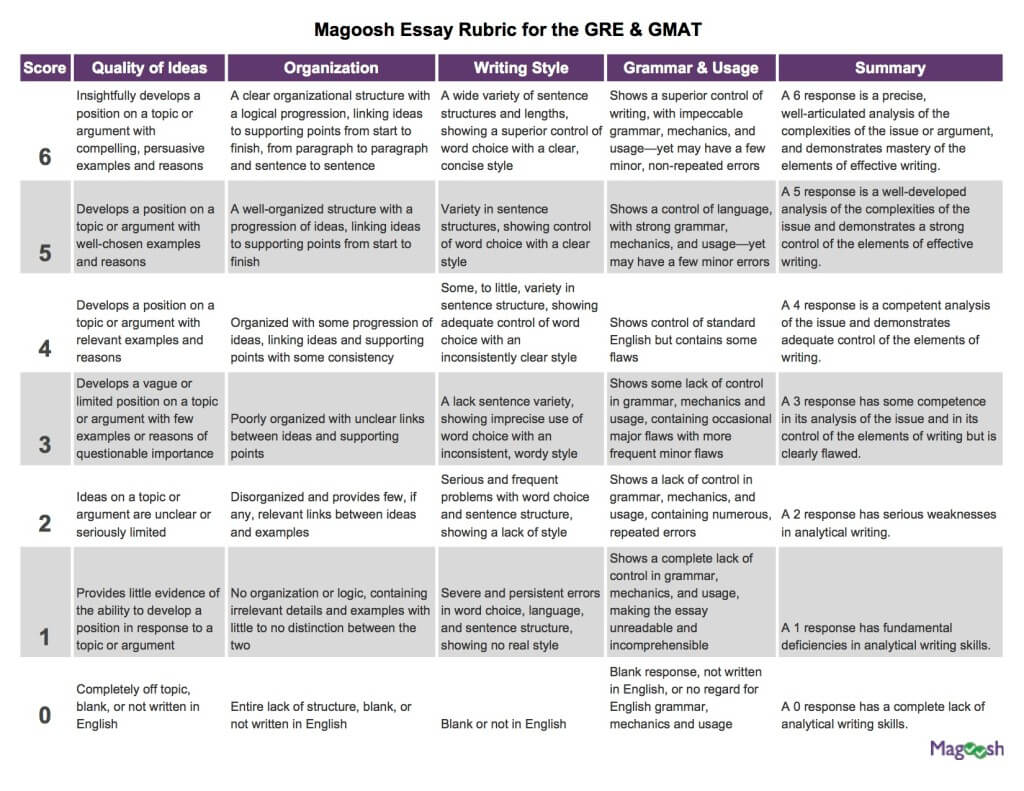The content in this post applies in 2025 to the new, shorter GRE!
How do I score my GRE essay?
Plenty of students want to improve their GRE analytical writing skills, and the only real way to do so is writing, and writing a lot.
But there is a catch-22 here: how do you improve your writing if you aren’t a good writer? How can you identify places to improve if you don’t know what needs improvement? How can you identify an error if you commit the error? These are all valid concerns, but trust me, you just need to start writing.
But we won’t send you out to sea without a life vest. We now have an essay rubric that breaks down the four aspects of writing that count towards your score—Quality of Ideas, Organization, Writing Style, and Grammar and Usage.
If you don’t know what those are now, you will soon. Each column represents one aspect of writing and each row represents a level from 0 to 6. Each cell of the rubric describes a specific aspect of writing at a specific level.
Download the Magoosh Essay Rubric (you can also download the printable PDF by clicking the image below) and get started!
How to Use the GRE Essay Grading Rubric
After completing the essay, you’ll need to check the four aspects of your writing. Even better, ask a friend to look over the essay and provide you a score. Give each aspect of your essay a score ranging from zero to six.
Total all four scores and find the average. Now you have a sense of your writing score. Round scores up as follows: Round a score of 4.25 to 4.5 and a score of 3.75 to 4.
Of course evaluating your own writing will be hard if you don’t know what to look for, but this is a perfect time to improve and practice. Taking a break between writing your essay and evaluating it will help to give you a more objective eye. Also, reading the essay aloud will help you to hear errors.
You can also access Magoosh’s Expert AI Tutor to grade your AW essays and get actionable feedback to improve your score with a Magoosh Premium Plan.
Quality of Ideas
This category evaluates the “meat” of your essay – the ideas that form your main argument. On the GRE you will be asked to evaluate and respond to an issue. You aren’t being judged on your expertise of the subject matter, but on your ability to make a sustained, well thought out argument. You’re showing your ability to deal with nuance and complexity while also articulating your own view of the issue.
Giving your essay a grade of 3.0 in this category would mean that it has only built a vague or partial argument about the issue. You’d only have a few examples or examples that are too simple or typical. An essay that’s achieving a 5.0 in this category would have developed much stronger examples and lines of reasoning. The quality of the examples would strengthen the overall argument. These are some things to ask yourself when grading this component of your essay:
- Are the ideas creative, compelling, and relevant?
- Did you use an expected, typical example?
- Did you talk about two sides of the issue or just one?
- Were you attacking the major components of the argument or just the minor ones?
- Were the reasons feasible, believable, and relevant to the topic?
Organization
Organization is one of the most important parts of any piece of writing – some would say the most important part. An essay can have a great argument and examples, but if it’s poorly organized the reader will never find them. The key to taking your reader on a journey, and convincing them of your point, is building your writing logically step-by-step.
An essay that does this just ok, meaning a 3.0 score, would have some organization, but it would be poor. It wouldn’t make sense to the reader how ideas are connecting, or building on each other. And evidence wouldn’t match the ideas it is meant to support. A good essay, a 5.0, would feature a solid organization that builds progressively from idea to idea. Ask yourself these questions to evaluate this part of your essay:
- Is there an introduction and conclusion?
- Does the response flow from paragraph to paragraph?
- Are there a lot of structure words to guide the reader, such as “for example,” “first,” or “further”?
- Is it easy to find the main idea of a paragraph and determine what the specific details supporting that idea are?
- Is it easy to understand the development of an idea and how it relates to the passage as a whole?
Writing Style
We’ve talked about your ideas and how you organize them, now it’s time to discuss how you express those ideas. Writing style is actually pretty simple – it’s just evaluating how well your sentences flow. Are you choosing the right words? Is there variation in your vocabulary and sentence structure to make your writing easy and pleasing to read?
A 3.0 essay will have sentences that have repeating structure. Think back-to-back sentences that start with the same words. Sentences will repeatedly be too long and wordy. And the essay will feature multiple instances of words being chosen imprecisely. A 5.0 essay on the other hand will have a clear sense of personal style. Sentences will show variety and a good command of vocabulary will be displayed. Here are questions to guide your evaluation of this section:
- Are there a mix of short sentences and long sentences?
- Are there a variety of sentence structures—simple, compound, complex, and compound-complex?
- Are the same words often repeated or are there a lot of synonyms and rephrasing?
- Are the sentences easy to read?
- Can the reader understand the ideas in a sentence?
- Do readers have to re-read a sentence multiple times to understand it?
Grammar and Usage
Finally, your essay needs to be grammatically correct. This can be challenging for test takers as most of us are used to writing with some form of grammar check. Make sure to really pay attention to this aspect of your writing as you practice.You want to make sure words are spelled correctly, the rules of grammar are followed, and that you are using correct punctuation.
A middle-of-the-road 3.0 essay will feature some major flaws and many more minor flaws. You’ll see a two point improvement by showing a strong control of the rules of grammar in mechanics and usage, even with a few minor flaws. Here are your questions to guide you through this final section:
- Are there misspelled words?
- Are the lists and comparisons parallel in structure?
- Are there any subject-verb agreement errors or pronoun-antecedent errors?
- Are there any run-on sentences or sentence fragments?
- Are commas, dashes, and semi-colons used correctly?
- Are there any modification problems—dangling modifiers or ambiguous ones?
Go to the Source
All the information that you see in our rubric is based on information published by ETS. If you need sample essays at different score levels or want to read more about the AWA and how it is graded, I highly recommend reading through An Introduction to the Analytical Writing Section of the GRE.
This is a long document and contains a lot of detail. If you want to see the different scoring level descriptions used to create our rubric, here they are:
- Score Level Descriptions
- GRE Scoring Guide – Analyze an Issue
- GRE Scoring Guide – Analyze an Argument
I recommend taking the time to become familiar with the difference between a “3” essay and a “4” essay. To truly become a better self-grader, or to even become a better grader for someone else, you need to become more familiar with the particular grading requirements of ETS.
Takeaway
Grading your AWA essay is not just useful for predicting your test day score. Critically, It’s an essential component of learning how to write better. When you receive feedback and act on it, you are building your writing muscles. This is an essential part of the test prep journey and critical for the work you’ll do in graduate school. Use this rubric to grade your own essay and see where you need to improve. Or get a Magoosh Premium Plan today to access our AI Expert Tutor that will grade your essay and give pointers on how to improve your score.
Note: Some students might wonder why the rubric is for the GRE and GMAT. Both test evaluate essays in the same way, so the rubric will work for either test.






